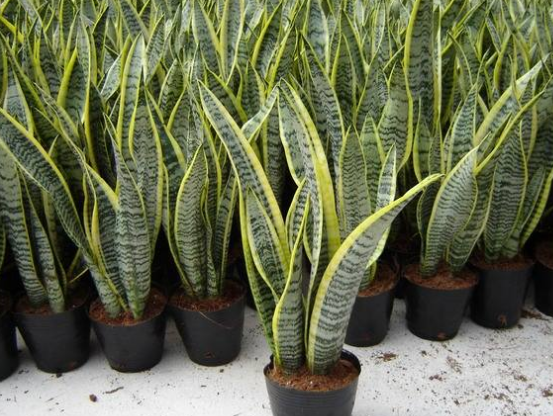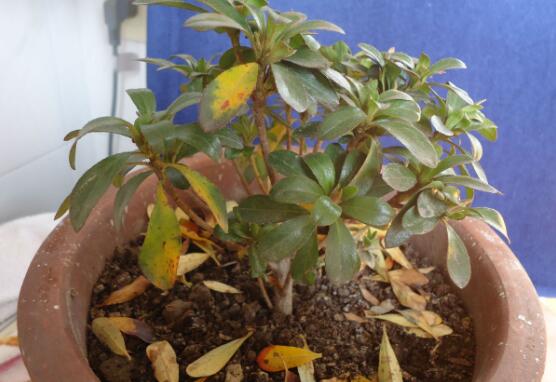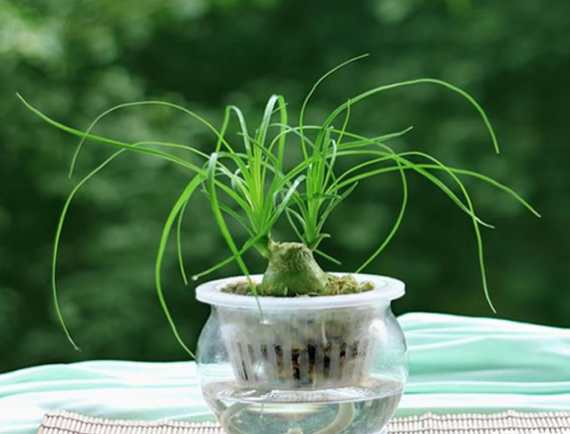What if the tiger skin orchid leaves turn yellow, please pay attention to these points / too much watering under the strong light
Tiger Pilan is a more common plant in people's life, and it is also a famous plant with tenacious vitality. of course, if you do not pay attention to conservation, there will still be all kinds of problems. What to do if the leaves of Tiger Pilan turn yellow? this is a problem that people often see. We can start with sunshine, watering and other aspects about this problem. Please follow the editor for details.
What to do about the yellowing of tiger Pilan leaves / find out the reason

1. Strong light irradiation
The yellowing of tiger skin orchid leaves usually occurs in summer, because the summer sun is too strong, which will make tiger skin orchid water evaporate too fast, long-term irradiation will make the top of tiger skin orchid leaves dry and gradually yellowing.
Solution: although Tiger Pilan naturally likes a warm environment, because the summer weather is too dry, it is recommended that we should pay attention to the summer shade to avoid too strong sunlight.
two。 Too much watering
In addition to strong light, too much watering is also one of the reasons for the yellowing of tiger Pilan leaves. Too much watering will gradually dim the color of tiger Pilan leaves.
Solution: Tiger Pilan is dormant in winter and generally stops growing, so it does not need water. It is recommended that you do not water Tiger Pilan in winter. Too much watering will only burden it at home.
3. The watering method is wrong
If the tiger skin orchid watering method is wrong, it will cause rotten spots on its leaves, so the tiger skin orchid watering must pay attention to the way and watering time.
Solution: Tiger Pilan had better not be watered at noon, and not under the leaves, preferably in the soil, so as to prevent the root of Tiger Pilan from rotting. If this has already happened, it is best to stop watering and slow it down for a few days. As long as the root of Tiger Pilan is still alive, it won't die.
4. Virus intrusion
Tiger skin orchid leaves yellowing, bacterial soft rot is also one of the reasons, this is a more common tiger skin orchid virus, the tiger skin orchid leaves will show a light yellowish green or grayish yellow, the stem will appear soft rot spots, very easy to break.
Solution: plants and people, sick on the treatment, tiger skin orchid in this case can choose drug treatment, you can choose soil germicidal fungicide to spray soil for sterilization.
After talking so much, we should know how to solve similar problems. Generally speaking, the yellowing of tiger Pilan leaves is a relatively common problem in people's life, and we should deal with it accordingly according to different situations. On the question of what to do with the yellowing of tiger Pilan leaves, the editor will introduce you here today. I hope I can bring you some help.
What about the yellowing of tiger Pilan leaves? what is the cause of yellowing?
Tiger-tailed orchid is a common indoor plant, which has some pathological changes due to poor management in the process of culture, such as softening, yellowing, withering, rotten and so on.
The reason for the yellowing of tiger skin orchid leaves:
Direct sunlight in summer
This situation shows that the top of the leaves are dry, gradually whiten and yellowing, without vigor and moisture, we can see that there is no vitality and moisture. This is easy to happen in summer, so we should pay attention to shade in summer to avoid too strong direct sunlight.
Too much watering
This situation shows that the color of tiger skin orchid leaves becomes dim. Generally, it has something to do with watering too often. Tiger Pilan has stopped growing in winter and does not need water. Too much watering will only increase its burden.
Improper watering method
This situation is manifested by rotten spots and traces on the leaves of Tiger Pilan. Generally caused by improper watering, the correct watering method is: avoid midday watering, do not water the leaves, it is best to pour into the soil around the basin.
Bacterial soft rot
This situation shows that the leaves are light yellowish green or grayish yellow, and there are water-like soft rot spots on the stems on the ground, which are easy to break. The rhizome is yellow and soft rotten, and the root is dead.
What if the tiger Pilan leaves turn yellow:
Choose the right soil
To choose the soil with good drainage, Hu Pilan has less strict requirements on the soil, but it is better to choose the soil with good drainage, and the mixture of rotten leaf soil and some sand can be selected.
Avoid direct sunlight in summer
Tiger Pilan prefers the sun and should keep sufficient light and place outside where the sun shines, but the sun is too strong at noon in summer and should be sheltered to some extent. When placed indoors, it should be placed against the window so that it can fully touch the sun. If the tiger skin orchid yellowed and softened due to excessive light, shade in time and transferred to a shady place for maintenance.
Pay attention to the growth temperature
The growth temperature of tiger skin orchid should be controlled between 16 and 30 ℃, and the corresponding heat preservation measures should be given in winter. Generally, frost injury will occur when the temperature is less than 5 ℃, and the leaves will be soft. You can put the plant in the sun, appropriately increase the plant temperature, and gradually recover.
Tiger Pilan likes warmth and is suitable to grow at a temperature of 16-30 degrees Celsius. Some anti-freezing measures should be given in winter. Generally, freezing injury occurs when the temperature is less than 5 degrees, which can be placed in the sun to increase the plant temperature.
Controlled watering quantity
The basin soil should be kept moist in spring and summer, but not stagnant water, and should be watered after the basin soil is completely dry in autumn and winter. Daily water can be used to clean the leaves to keep the plant beautiful and make the plant grow better. Do not water when the winter temperature is lower than 10 ℃, so as to avoid freezing damage. Watering should be in the morning or in the evening.
Prevention of diseases and insect pests
When watering, you should avoid splashing on the leaves, find diseased leaves, remove them and destroy them in time. When you get sick, you can spray 12% green copper 600x solution or 72% agricultural streptomycin 4000 times solution. Spray once every 7 days and 3 times in a row.
What if the leaves of Tiger Pilan turn yellow and soft?
The reason for the yellowing and softening of tiger skin orchid leaves
Direct sunlight in summer
This situation shows that the top of the leaves are dry, gradually whiten and yellowing, without vigor and moisture, we can see that there is no vitality and moisture. This is easy to happen in summer, so we should pay attention to shade in summer to avoid too strong direct sunlight.
Too much watering
This situation shows that the color of tiger skin orchid leaves becomes dim. Generally, it has something to do with watering too often. Tiger Pilan has stopped growing in winter and does not need water. Too much watering will only increase its burden.
Improper watering method
This situation is manifested by rotten spots and traces on the leaves of Tiger Pilan. Generally caused by improper watering, the correct watering method is: avoid midday watering, do not water the leaves, it is best to pour into the soil around the basin.
Bacterial soft rot
This situation shows that the leaves are light yellowish green or grayish yellow, and there are water-like soft rot spots on the stems on the ground, which are easy to break. The rhizome is yellow and soft rotten, and the root is dead.
The treatment method of yellowing and softening the leaves of Tiger Pilan
Choose the right soil
To choose the soil with good drainage, Hu Pilan has less strict requirements on the soil, but it is better to choose the soil with good drainage, and the mixture of rotten leaf soil and some sand can be selected.
Avoid direct sunlight in summer
Tiger Pilan prefers the sun and should keep sufficient light and place outside where the sun shines, but the sun is too strong at noon in summer and should be sheltered to some extent. When placed indoors, it should be placed against the window so that it can fully touch the sun. If the tiger skin orchid yellowed and softened due to excessive light, shade in time and transferred to a shady place for maintenance.
Pay attention to the growth temperature
The growth temperature of tiger skin orchid should be controlled between 16 and 30 ℃, and the corresponding heat preservation measures should be given in winter. Generally, frost injury will occur when the temperature is less than 5 ℃, and the leaves will be soft. You can put the plant in the sun, appropriately increase the plant temperature, and gradually recover.
Tiger Pilan likes warmth and is suitable to grow at a temperature of 16-30 degrees Celsius. Some anti-freezing measures should be given in winter. Generally, freezing injury occurs when the temperature is less than 5 degrees, which can be placed in the sun to increase the plant temperature.
Controlled watering quantity
The basin soil should be kept moist in spring and summer, but not stagnant water, and should be watered after the basin soil is completely dry in autumn and winter. Daily water can be used to clean the leaves to keep the plant beautiful and make the plant grow better. Do not water when the winter temperature is lower than 10 ℃, so as to avoid freezing damage. Watering should be in the morning or in the evening.
Prevention of diseases and insect pests
When watering, you should avoid splashing on the leaves, find diseased leaves, remove them and destroy them in time. When you get sick, you can spray 12% green copper 600x solution or 72% agricultural streptomycin 4000 times solution. Spray once every 7 days and 3 times in a row.
- Prev

What if the azaleas lose their leaves? too little fertilization and too much watering / soil alkali is the key.
There is no need to describe the beauty of azaleas too much. Everyone who has seen them knows that they are really lovely flowers like flames. However, in the process of breeding, due to various reasons, rhododendrons will have all kinds of problems, such as rhododendron leaves yellowing, azaleas losing leaves and so on. What about rhododendrons losing leaves?
- Next

Wine bottle orchid leaves yellow how to do, 5 ways to teach you to easily solve / lack of light
Wine bottle orchid is a common plant in people's life. Because of its unique appearance, it is obviously different from ordinary plants and gives people a novel feeling, so it is loved by many people. Of course, yellowing in good-looking plants will also affect the overall beauty. What about the yellowing of orchid leaves in wine bottles?
Related
- Fuxing push coffee new agricultural production and marketing class: lack of small-scale processing plants
- Jujube rice field leisure farm deep ploughing Yilan for five years to create a space for organic food and play
- Nongyu Farm-A trial of organic papaya for brave women with advanced technology
- Four points for attention in the prevention and control of diseases and insect pests of edible fungi
- How to add nutrient solution to Edible Fungi
- Is there any good way to control edible fungus mites?
- Open Inoculation Technology of Edible Fungi
- Is there any clever way to use fertilizer for edible fungus in winter?
- What agents are used to kill the pathogens of edible fungi in the mushroom shed?
- Rapid drying of Edible Fungi

